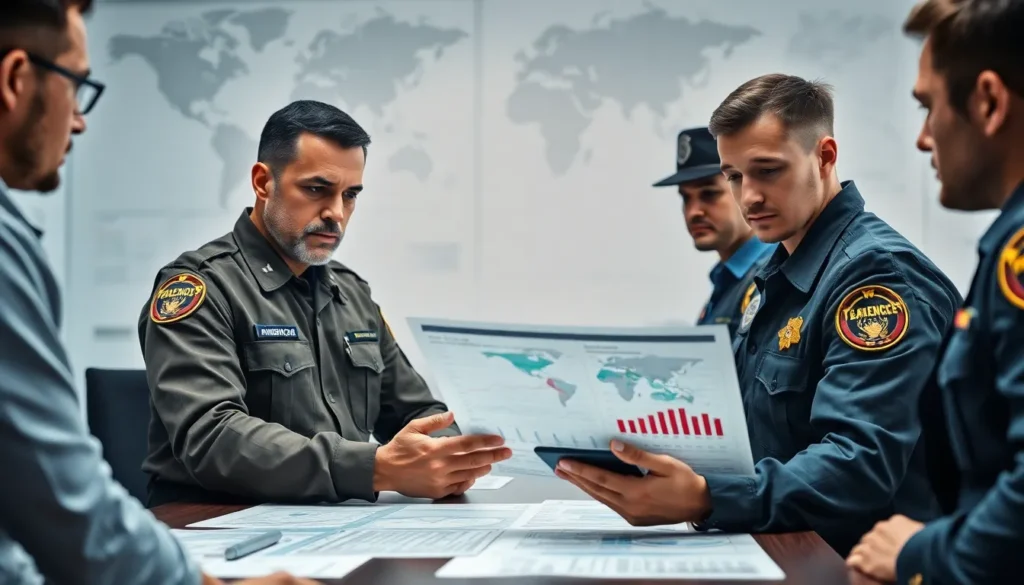In an increasingly interconnected world, understanding the landscape of international crime has never been more crucial. The rise of transnational criminal activities poses significant challenges for law enforcement agencies and governments alike. From human trafficking to cybercrime, the complexities of these issues demand comprehensive reporting and analysis.
International crime reports serve as vital tools for tracking trends and patterns across borders. They provide insights into the evolving nature of crime and help policymakers develop effective strategies to combat it. By examining these reports, readers can gain a clearer perspective on how global crime impacts societies and economies, highlighting the need for collaboration in addressing these pressing issues.
Table of Contents
ToggleOverview of International Crime Reports
International crime reports provide crucial data about global criminal activities. These reports track trends in various forms of crime, including human trafficking, drug trafficking, and cybercrime. By offering accurate statistics, they help policymakers and law enforcement identify emerging threats.
Reports are typically prepared by organizations like INTERPOL, the United Nations Office on Drugs and Crime (UNODC), and regional bodies. Each organization employs diverse methodologies to collect data, ensuring a comprehensive overview of crime levels across different countries. Reports often include geographic crime distribution, demographic information on victims and offenders, and analyses on the effectiveness of criminal justice systems.
International crime reports serve multiple purposes:
- Trend Identification: They highlight increasing or decreasing crime rates, allowing for targeted responses.
- Policy Guidance: Reports inform the creation of laws and initiatives aimed at combating crime.
- Resource Allocation: Data helps governments prioritize funding for law enforcement and prevention programs.
- International Cooperation: Reports foster collaboration among nations, facilitating joint efforts against transnational crime.
The timely release of international crime reports can significantly influence public awareness and international relations. Active dissemination of these findings promotes discussions on crime prevention strategies and the importance of building stronger global partnerships.
Importance of International Crime Reports

International crime reports play a vital role in understanding and addressing global crime issues. They provide essential insights that drive security measures and inform policy decisions.
Role in Global Security
International crime reports are crucial for enhancing global security. They deliver data that highlights emerging threats, enabling law enforcement agencies to prepare and respond effectively. By identifying patterns in transnational crime, such as drug trafficking or terrorism, these reports assist in the allocation of resources and deployment of strategies to mitigate risks. Organizations like INTERPOL use data from these reports to improve coordination among member countries, fostering collaborative efforts against cross-border crime. This cooperation strengthens international security frameworks and promotes safer environments for citizens.
Impact on Policy Making
International crime reports significantly influence policy making at national and international levels. Policymakers rely on the evidence presented in these reports to shape legislation and allocate funding toward crime prevention initiatives. Reports detailing rising trends in cybercrime or human trafficking prompt governments to implement targeted interventions and preventive measures. Data-driven insights from organizations like the United Nations Office on Drugs and Crime (UNODC) facilitate informed discussions and enhance the effectiveness of policies aimed at reducing crime rates. By guiding resource allocation, these reports ensure that governmental strategies align with current realities, ultimately contributing to safer societies.
Key Findings from Recent Reports
Recent international crime reports reveal significant insights into global crime patterns. The findings underscore trends in criminal activities and present noteworthy case studies highlighting the impact of these issues worldwide.
Trends in International Crime
Trends in international crime show a notable increase in various criminal activities. Human trafficking remains a critical concern, affecting millions annually, with reports estimating over 25 million victims globally. Cybercrime continues to escalate as well, with a reported increase of 600% in phishing attacks during the COVID-19 pandemic. Drug trafficking, particularly opioids, shows a disturbing rise, with over 700,000 deaths linked to drug overdoses in the U.S. alone in 2021. These trends indicate the need for enhanced collaboration and innovative strategies to combat these growing threats.
Notable Case Studies
Notable case studies provide further insight into the complexities of international crime. The trafficking of Rohingya refugees in Southeast Asia highlights the intersection of human rights violations and organized crime, illustrating a perilous journey faced by many. The 2020 arrest of a major drug cartel leader in Mexico exemplifies the ongoing battle against drug trafficking networks that extend beyond borders. In another instance, a multinational operation in 2022 targeted cybercriminals responsible for a widespread ransomware attack, showcasing effective international cooperation. These case studies emphasize the multifaceted nature of international crime and the necessity for comprehensive approaches to address these challenges effectively.
Challenges in Data Collection
Collecting accurate data for international crime reports presents significant challenges. Variability in reporting standards and issues with compliance complicate the process, hindering the effectiveness of crime tracking.
Variability in Reporting Standards
Variability in reporting standards across nations affects data consistency and reliability. Different countries utilize distinct methodologies for defining and recording crimes. In some regions, certain criminal activities may go unreported or misclassified due to cultural perceptions or lack of resources. For example, human trafficking may not be accurately documented where legal definitions differ from international norms or where victims fear reporting their situations. Additionally, variations in legal frameworks and enforcement practices can lead to disparities in reported crime rates, skewing the overall understanding of global crime patterns.
Issues with Compliance
Issues with compliance further exacerbate data collection challenges. Many nations lack the resources or infrastructure necessary to comply with international reporting guidelines set by organizations like INTERPOL and UNODC. In some instances, political motivations influence the accuracy of reported data, as governments may underreport crime statistics to present a safer image to the international community. Corruption within law enforcement also impacts compliance, as officers might bypass recording certain offenses to avoid drawing attention to criminal activities. These factors create gaps in the data, limiting the ability to fully comprehend the global landscape of crime.
Future Directions for International Crime Reporting
Future directions for international crime reporting focus on enhancing data accuracy, improving collaboration, and adopting advanced technology. Global stakeholders aim to address challenges in data collection by standardizing reporting methodologies. By establishing uniform definitions and metrics for crime categories, organizations can reduce inconsistencies and improve the reliability of international crime data.
Enhanced collaboration among countries represents another key direction. Establishing networks and partnerships enables the exchange of intelligence and best practices in combating international crime. These collaborations foster a shared understanding of threats and strengthen collective responses against transnational crime.
Technological advancements offer significant potential for future crime reporting. Utilizing artificial intelligence and big data analytics can streamline data processing, increasing the speed and accuracy of reporting. Moreover, leveraging online platforms for real-time data sharing can support quick decision-making and prompt actions against emerging threats.
Focused training programs for law enforcement agencies play a crucial role in improving the quality of data collection. By equipping personnel with the necessary skills to identify and report crime, countries can enhance their reporting accuracy.
Adopting a victim-centered approach in crime reporting will also shape future practices. This method prioritizes the experiences and rights of victims, ensuring accurate representation of crime prevalence. Engaging victims can lead to more comprehensive data and improved crime prevention strategies.
Integrating social media monitoring into crime reports presents another innovative direction. Tracking online activities can provide insights into cybercrime trends and help law enforcement effectively address these threats.
Overall, future international crime reporting will emphasize accuracy, collaboration, technology, and a victim-centered approach, ultimately strengthening global responses to crime.
International crime reports play a crucial role in addressing the complex landscape of global crime. By providing essential data and insights, these reports enable countries to understand emerging threats and devise effective strategies. The ongoing challenges in data collection highlight the need for improved methodologies and collaboration across borders.
As the world continues to grapple with issues like human trafficking and cybercrime, the importance of accurate reporting cannot be overstated. Future efforts must focus on enhancing data accuracy and leveraging technology to support real-time information sharing. Ultimately, a united approach will strengthen global responses and foster safer societies for everyone.





